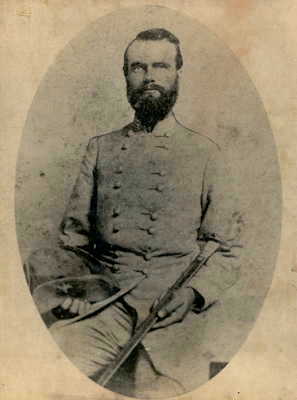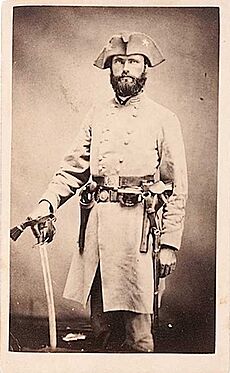Richard Montgomery Gano facts for kids
Quick facts for kids
Richard Montgomery Gano
|
|
|---|---|
 |
|
| Born | June 17, 1830 Bourbon County, Kentucky |
| Died | March 17, 1913 (aged 82) Dallas, Texas |
| Place of burial |
Oakland Cemetery, Dallas, Texas
|
| Allegiance | Confederate States of America |
| Service/ |
Confederate States Army |
| Years of service | 1861–1865 (CSA) |
| Rank | Brigadier General |
| Battles/wars | American Civil War |
Richard Montgomery Gano (born June 17, 1830 – died March 27, 1913) was an important figure in American history. He was a physician (doctor), a Protestant minister, and a brigadier general in the Confederate army during the American Civil War.
Contents
Early Life and Career
Richard Gano was born in Bourbon County, Kentucky, on June 17, 1830. His family had a strong history of service. His grandfather was a general in the War of 1812, and his father was a minister.
Education and Medical Work
Richard was baptized into his church when he was ten years old. At age twelve, he started college at Bacon College in Kentucky. He finished his studies at Bethany College around 1847. After that, he went to Louisville Medical Institute and became a doctor in 1849.
He worked as a doctor in Kentucky and then in Baton Rouge, Louisiana. For two years, he was even the doctor for the Louisiana State Prison.
Family and Move to Texas
In 1853, Richard married Martha ("Mattie") Jones Welch. They had twelve children together, and nine of them grew up to be adults. Martha passed away in 1895 in Dallas, Texas. Interestingly, Richard Gano's granddaughter, Allene Stone Gano, was the mother of the famous billionaire Howard Hughes.
In 1859, Gano moved his family to Grapevine Prairie, Texas. This area is now part of the Dallas/Fort Worth International Airport. There, he started farming and raising animals, but he also kept working as a doctor. He was especially interested in bringing fast race horse breeds from Kentucky to Texas.
Community Leader
Richard Gano quickly became involved in his new community. He helped local groups deal with Comanche raiding parties. For his efforts, the citizens gave him a special sword. In 1860, he was elected to the Texas legislature. He worked on important issues like protecting the frontier and helping farmers.
Civil War Service
In 1861, Richard Gano left his job in the Texas legislature to join the Confederate army. On June 1, he became a captain of a group of mounted riflemen he had put together, called the "Grapevine Volunteers."
Early Cavalry Actions
By early 1862, his unit became part of the Confederate service. They joined Col. John Hunt Morgan's cavalry in Tennessee. Captain Gano and his company took part in Morgan's first raid into Kentucky in July 1862. He also participated in a raid on the Louisville & Nashville Railroad in August. During this time, he was promoted to major. He commanded a larger cavalry group at the Battle of Gallatin.
In September 1862, Gano's group became the start of the new 7th Kentucky Cavalry Regiment. He was promoted to colonel. His regiment fought in many battles during Gen. Edmund Kirby Smith's invasion of Kentucky. This included the Battle of Perryville in October 1862.
Leading Brigades
By February 1863, Colonel Gano was in charge of the First Cavalry Brigade. On April 3, his brigade was attacked by a large Union force at Snows Hill, Tennessee. They had to retreat. Later, many of Morgan's forces were destroyed during Morgan's Raid. The remaining soldiers joined Gano's brigade. In September 1863, Colonel Gano commanded both his own brigade and Morgan's survivors at the Battle of Chickamauga.
Gano became ill and left active service for a while. Then, he was promoted to brigadier general. He took the remaining soldiers from his original Texas cavalry unit back to Bonham, Texas. In October 1863, he took command of all Texas cavalry units operating west of the Mississippi River.
Key Engagements
In December 1863, Gano's brigade captured Waldron, Arkansas. In April 1864, he was wounded in the arm during a fight in Arkansas. Two months later, he led an attack on Fort Smith, Arkansas. On July 27, 1864, he led another attack at the Battle of Massard Prairie.
A few weeks later, Gano's brigade moved to Indian Territory. On September 19, he commanded both his Texas cavalry and Brig. Gen. Stand Watie's Indian cavalry. This was at the second Battle of Cabin Creek. Gano was wounded again in this battle. However, the Confederate forces captured a large federal supply train. This train had about three hundred wagons and 750 mules, worth more than two million dollars. General Kirby Smith praised this as "one of the most brilliant raids of the entire war."
In January 1865, Gano's brigade was ordered to Nacogdoches. However, the war ended on May 26, when the Confederate army west of the Mississippi surrendered. Gano had been recommended for promotion to major general, but the war ended before it could happen.
Life After the War
After the war, in 1866, Gano returned to Kentucky. There, he became an ordained minister in the Disciples of Christ church. His own father helped ordain him.
Minister and Businessman
By 1870, he had moved to Dallas, Texas. He continued to raise animals and preached regularly. Over the next thirty years, he helped start many churches in north Texas and Kentucky. He was also active in the Prohibition movement, which aimed to ban alcohol.
As a stockman, Gano brought many important animal breeds to Texas. This included different types of cattle, horses, sheep, and hogs. He was also a successful businessman. He started a real estate company with two of his sons. He also served as a director at a bank in Dallas. These businesses helped him become a millionaire. He was also active in the United Confederate Veterans, a group for former Confederate soldiers.
The G4 Ranch
With his sons, John T. Gano and Clarence M. Gano, he started the Estado Land and Cattle Company. Richard Gano was the vice president. This company created the G4 Ranch in the Big Bend area of Texas in the late 1880s and early 1890s. The G4 was one of the largest ranches in that region. It covered 55,000 acres and leased other land. The ranch headquarters were at Oak Spring, which is now part of Big Bend National Park. The ranch stretched from Agua Fria Mountain to the Rio Grande river.
Richard Gano passed away on March 27, 1913, in Dallas. He is buried in Oakland Cemetery.
Legacy
In 1974, the historic "dog-trot" house that Gano bought in Grapevine Prairie in 1857 was moved to Dallas Heritage Village. This village is located on Gano Street, which is named after Richard Gano.
There are also groups that honor his memory. The Gen. Richard M. Gano Chapter #2433 of the United Daughters of the Confederacy meets in Irving, Texas. The Brig. Gen. Richard M. Gano Camp #2292 of the Sons of Confederate Veterans meets in Grapevine, Texas.
Gano's personal papers, which include his father's papers, are kept in the archives of Abilene Christian University in Abilene, Texas.
See also


